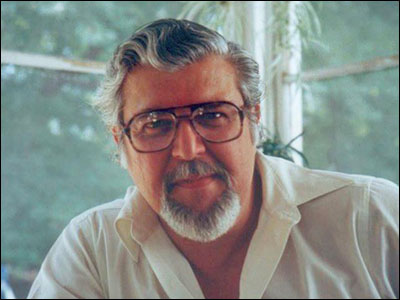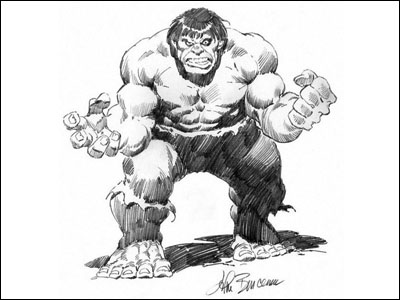Brian Fies asks…
John Buscema is one of Marvel's all-time great artists and his "How To" book is a classic on most cartoonists' shelves, but in every interview I've read with him he seemed very ambivalent about drawing superheroes. It was just a job to him, one he didn't particularly enjoy. Yet your Comic-Con schedule for 2001 shows him doing three panels, and I'm curious about your impression of him then. Was he engaged, happy, grumpy? That late in his career (he died in 2002), had he made some peace with superheroes? Or is my impression of him just wrong?
Well, I can't claim to have known John as well as some people so you might want to put this question to one of them. I can just give you my impression from having him on several panels at two Comic-Cons and having one long — I mean like 3+ hours — dinner with him. And I'll tell you two things I learned about comic book artists, especially those from his generation…
One is that every artist has things they prefer to draw and they're happy when they get to draw those things and less happy when they don't. I've worked with some very good artists who hated to draw cars or machinery or horses. John didn't like drawing New York City and people in suits…and a lot of super-hero assignments called for street scenes. Since he was contributing to the plots, he also had to understand the characters and their powers and sometimes how they'd functioned in other comics.
He was happier with Conan or any strip in mythical lands or period pieces. He also told me that he had such great admiration for Jack Kirby — and an awareness that some folks at Marvel wanted him to draw more like Jack — that he sometimes felt uncomfy drawing a Kirby strip, especially when he had to keep looking at Jack's issues for reference.

That's all one thing. The other is that most of his work was done on an assembly-line basis. After it left him, it went to a letterer who would put lettering where John didn't think it should be, then to an inker who might change a lot of what John intended…or simply misunderstand what he had drawn.
As you may have heard, John did not like most of the inkers who finished his pencil art. There were only two he ever really cared for. One was his brother, Sal Buscema. The other was Frank Giacoia, who was probably the Marvel inker most Marvel pencilers wanted to have ink their pencils when they couldn't do it themselves. John's opinion of the rest ranged from "terrible" to "not as bad as some others."
On one of the panels that year, he launched into a short speech about how awful he thought some of them were, horrifying a couple of attendees who thought that John Buscema — plus certain of those inkers he said he hated — produced wonderful work. One fellow in the audience approached me after the panel to ask why John Buscema would have lied and said he didn't love the work of this one inker. The fan thought that combo was so magnificent, John couldn't have not loved it.
John wasn't lying. He was just saying aloud something that some other artists might not have said in public.
But as we've discussed here, most artists of that generation didn't want to be pencilers or inkers. They wanted to create finished art themselves. If you develop the interest/talent for drawing, you grow up doing it as a solitary act of creation. If you were twelve years old and copying the work of Alex Raymond or Hal Foster out of the funny pages, as most comic artists of John's generation did, the fantasy was not to draw it in pencil and then let someone else hand it to a person of their choosing to finish in ink.
One guy penciling and then another inking was largely invented for the publisher's convenience. It was not something that most artists liked and even the ones who preferred to only do one often felt they were matched with the wrong person. There were a couple of inkers who declined to ink Gene Colan's work because, as one put it, "I think he's an incredible artist but I don't understand his drawing well enough to touch it."
Most artists like control of their work to some extent. John had very little control — not of the inking or the coloring or the printing. It bothered a lot of them even though most were afraid to say so. And in John's case, I think he was often assigned to strips at Marvel not because anyone thought his style was right for them but because the book was behind schedule and he was so fast and dependable, he could get it on schedule.
He was a great crisis-solver for editors. As anyone who has that rep can tell you, the downside of that is that you keep getting brought in when there's a crisis.

Don't get me wrong: John was very pleased with his career in comics. He'd worked intermittently in advertising and when he did, he spent a lot of time commuting to far-away offices and a lot of time in meetings with people who couldn't draw and had bad ideas as to what should be drawn. Working for Marvel, John got to stay at home all day and draw…and that makes some artists very happy.
He just might have been happier on some other strips at times…and a lot happier if he could have penciled and inked more. As I think I said here, if he (or Curt Swan or Gil Kane or many others of those generation who mostly penciled-only), had been able to ink a lot more, I think amazing work would have resulted. But they were pressed to do pencils-only and their page rates were often adjusted to discourage inking.
John Buscema always did excellent work and he did a lot of it, sometimes thrice as fast as your average penciler. The quality in the published books varied a lot and some of that was the inkers. He was right that some of them weren't very good or didn't understand his drawing. But the quality also varied depending on how much he liked the assignment. He was never bad but I think you can tell sometimes that he really, really liked a certain assignment.
